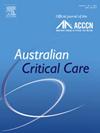在接受持续肾脏替代治疗的危重患者中,净超滤强度与临床结果的关联:一项系统回顾、荟萃分析和试验序贯分析。
IF 2.6
3区 医学
Q2 CRITICAL CARE MEDICINE
引用次数: 0
摘要
背景:净超滤(unet)已被用于长期接受持续肾替代治疗的危重患者的液体管理。尽管其广泛应用,但unet强度与临床结果之间的相关性仍存在争议。方法:检索自成立至2023年11月30日的电子数据库(PubMed、Embase、Web of Science和Cochrane数据库)。所有可能的研究都包括了以下结果:全因死亡率、肾功能恢复和住院时间。结果:6项队列研究共纳入6209例患者。在危重患者中,unet强度与死亡率(优势比[OR] = 0.90, 95%可信区间[CI] = 0.68-1.21, p = 0.49, I2 = 84%)或肾脏恢复(OR = 0.96, 95% CI = 0.57-1.61, p = 0.87, I2 = 75%)均无显著相关性。然而,高强度unet与急性肾损伤(AKI)患者较低的死亡率相关(OR = 0.73, 95% CI = 0.59-0.90, p = 0.004, I2 = 67%)。此外,该研究还揭示了高unet强度与较长的住院时间之间的显著相关性(加权平均差= 3.34 d, 95% CI = 2.64-4.03, p2 = 0%)。结论:unet强度与危重患者死亡率或肾脏恢复的相关性不足。然而,在危重患者中,高unet强度与住院时间增加有关。本文章由计算机程序翻译,如有差异,请以英文原文为准。
Association of net ultrafiltration intensity and clinical outcomes among critically ill patients receiving continuous renal replacement therapy: A systematic review, meta-analysis, and trial sequential analysis
Background
Net ultrafiltration (UFnet) has been used in the fluid management of critically ill patients undergoing continuous renal replacement therapy for an extended duration. Despite its widespread application, the correlation between UFnet intensity and clinical outcomes remains controversial.
Methods
Electronic databases (PubMed, Embase, Web of Science, and the Cochrane database) were searched from inception to November 30, 2023. All possible studies that examined the following outcomes were included: all-cause mortality, recovery of kidney function, and length of hospital stay.
Results
A total of 6209 patients from six cohort studies were included. There was no significant association observed between UFnet intensity and either mortality (odds ratio [OR] = 0.90, 95% confidence interval [CI] = 0.68–1.21, p = 0.49, I2 = 84%) or renal recovery (OR = 0.96, 95% CI = 0.57–1.61, p = 0.87, I2 = 75%) among critically ill patients. However, a high intensity of UFnet was associated with lower mortality in patients with acute kidney injury (AKI) (OR = 0.73, 95% CI = 0.59–0.90, p = 0.004, I2 = 67%). Furthermore, the study revealed a noteworthy correlation between a high UFnet intensity and a longer length of hospital stay (weighted mean difference = 3.34 d, 95% CI = 2.64–4.03, p2 = 0%).
Conclusions
The association between UFnet intensity and mortality or renal recovery in critically ill patients is insufficient. However, a high UFnet intensity is associated with an increasing length of hospital stay among critically ill patients.
求助全文
通过发布文献求助,成功后即可免费获取论文全文。
去求助
来源期刊

Australian Critical Care
NURSING-NURSING
CiteScore
4.90
自引率
9.10%
发文量
148
审稿时长
>12 weeks
期刊介绍:
Australian Critical Care is the official journal of the Australian College of Critical Care Nurses (ACCCN). It is a bi-monthly peer-reviewed journal, providing clinically relevant research, reviews and articles of interest to the critical care community. Australian Critical Care publishes peer-reviewed scholarly papers that report research findings, research-based reviews, discussion papers and commentaries which are of interest to an international readership of critical care practitioners, educators, administrators and researchers. Interprofessional articles are welcomed.
 求助内容:
求助内容: 应助结果提醒方式:
应助结果提醒方式:


